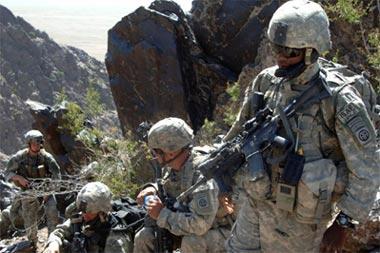FORT LAUDERDALE, Fla. -- The Army's long-standing problem with rapid response will only get worse as the force returns to the U.S. and funding cuts eat away at mobility, Army and defense industry officials said Friday.
"These are tough days" for military planners charged with getting to the next fight, said Army Lt. Gen. Raymond Mason, the Army deputy chief Staff for Supply and Logistics.
"We're becoming much more of a CONUS (Continental U.S.) based Army," Mason said. "The tough part is when you've got to go somewhere. We're not so good at getting out of Dodge when you get that call in the middle of the night."
Mason spoke at a panel discussion on "Transition to Sustainment" at the Association of the U.S. Army's Winter Symposium. The dominant topic presented in salvos of Power Point displays has been the effects of military budget cuts already underway and soon to be exacerbated under the legislative process called sequestration.
Under current projections, the Defense Department's fiscal 2013 budget would take a $52 billion hit -- $24 billion for the Army -- all in the last seven months remaining in the current fiscal year.
In addition to sequester set to begin on March 1, and the projected $500 billion in cuts for defense spending over 10 years that would follow, the military also faces another deadline on March 27, when the Congressional continuing resolution on current defense spending expires.
Defense Secretary Leon Panetta has warned that the combined effects of sequestration and the continuing resolution, if allowed to continue for the rest of the fiscal year, would require "drastic and irreversible" actions, including furloughs for civilian personnel, reduced training and delays in buying weapons.
One of the immediate effects of the cuts will be less reliance on contractors for the maintenance and repair of equipment, said Lt. Gen. Patricia McQuiston, deputy commanding general at Army Materiel Command.
Maintenance "will be put back in the hands of soldiers" at depots across the U.S., McQuiston said, as the Army downsizes through a period of uncertain funding. The problem for the planners, McQuiston said, was that "we don't know the slope of that period of downsizing."
The Army's difficulties with rapid response will likely be matched by the inability of the defense industry to gear up for the next conflict, said Mike Ivy, vice president and general manager for Oshkosh Defense.
"I think about how we transition from a world of high volumes to a world of seemingly low volumes that we face," Ivy said. He noted that Oshkosh was able to produce 8,000 MRAP (Mine Resistant, Ambush Protected) vehicles in little over a year in response to the improvised explosive device threat during the height of the Iraq war.
"We simply will not have the ability to respond similarly going forward" as the military cuts funding and Oshkosh cuts its workforce, Ivy said. Oshkosh has 3,500 workers in its defense division.
Then there is what Lt. Gen. Mason called the loss of the "Kuwait factor." For the wars in Iraq and Afghanistan, the Army was able to use Kuwait as a forward base for the slow buildup of troops and equipment.
The next enemy has learned the lessons of Iraq and Afghanistan and "will try to keep us from building up in place, like Kuwait," Mason said. Getting to the battlefield, always a problem for the increasingly heavy Army, is "what's keeping me up at night," Mason said.
He noted the difficulty the Army had in getting to Haiti, where the landings were not contested, after the earthquake in 2010.
"We did not exactly cover ourselves with glory trying to get out of Dodge and get to Haiti," Mason said.
Update: A previous version of this article incorrectly stated that Oshkosh could lay off 3,500 workers should sequestration occur.





























